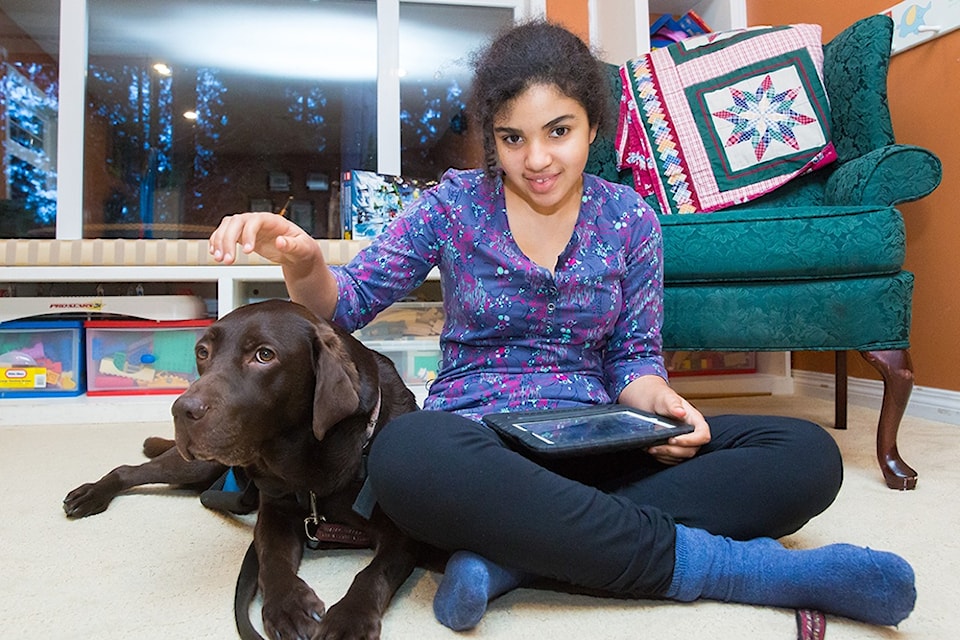SURREY — When the Kaler family brought home its autism support dog, the change was almost instantaneous.
"It's night and day," mom Nicole Kaler says of the family's life before and after getting Pepe.
Kaler's eldest daughter, Maya, was diagnosed with autism before she turned three.
"It was that typical regression," Kaler remembers.
At about 19 months, Maya started using fewer and fewer words, she wasn't walking properly and was sleep disordered.
"And she was just not engaged," says Kaler.
Maya, who is now 13, is considered severely affected by autism. She is non-verbal and needs to have someone with her at all times.
"You don't know what she's going to do," says her mom.
Like many people with autism, Maya, who is the eldest of three, also has a tendency to run off, which can make outings difficult and stressful, especially with two other youngsters to worry about. Kaler kept using a stroller until Maya outgrew it at age six. The family also tried hiring someone to help out during outings, but that meant finding a qualified individual and then relying on them whenever the family wanted to have a day out.
It took the spontaneity out of life and encroached on the family's privacy.
"We started sort of limiting what we did," she says. "It just felt like with just a little something we could be so much more."
In 2008, Kaler found that something the family needed. She was flipping through the newspaper when she came across a story about a North Delta family receiving the first autism support dog from Ladner-based B.C. Guide Dogs.
Kaler called the organization and had the application couriered over. Nine months later, the family received Pepe, a chocolate lab.
Aside from offering comfort and companionship to an autistic child, a support dog also acts as an anchor via a belt around the child's waist. The dogs do not guide the child, as a guide dog does for someone who is blind, however the canines are trained to sit when the child tries to run or pull away.
Within days of getting Pepe, Kaler was taking her three children to the park - just the four of them.
"That was just the start of being able to do things on our own," she says.
The family was able to go to the mall or the grocery store without having to worry about what might happen if Maya suddenly bolted. It was even able to take a family trip to Disneyland.
"That would not have been possible before," Kaler says. "For me, it was huge."
As Maya has got older, she has become accustomed to holding Pepe's leash when the family is out and the pair no longer needs to use the belt attachment.
While Maya has an educational assistant while at school, Pepe also started tagging along when she reached Grade 5.
"I really was thinking of high school," Kaler says.
Today, Pepe attends classes with Maya at Elgin Park Secondary, and even has her own student ID card.
Kaler says Pepe not only provides that comfort and companionship to Maya while she's at school, the dog has also acted as an ice breaker for students who might be curious about Maya but afraid to ask.
"It's been a really essential piece of what we needed to move forward with Maya in a dignified way."
Kaler says B.C. Guide Dogs has been incredibly supportive of the family since the beginning. From making sure it had all the supplies needed to take care of a dog to helping the school district create a policy around guide dogs in the classroom, the agency is always there to help.
B.C. Guide Dogs recently launched a six-month crowdfunding campaign aimed at raising $50,000 to start training a new crop of puppies. It can take up to two years and a total of $35,000 to train one dog.
After going through basic puppy training, when they are a minimum of 14 months old the dogs are sent for advanced training, where they are assessed and sent for either guide or support dog training.
Trainer Jaime Arnup says an autism support dog must be good around young children, a bit lower energy, patient, reliable and, usually, on the larger side.
"They physically need to be able to do the job," she says.
Advanced training, which takes at least 10 weeks, works on teaching the canines obedience, some basic games that can help the child with co-ordination and motor skills, and to crawl across the floor and lay on the child's lap, something that many children with autism find comforting.
(function(){var e=document,t=e.createElement("script");t.type="text/javascript";t.async=true;t.src=(e.location.protocol.indexOf("https")==0?"https://s-":"http://")+"static.fundrazr.com/widgets/loader.js";var n=e.getElementsByTagName("script")[0];n.parentNode.insertBefore(t,n)})()
